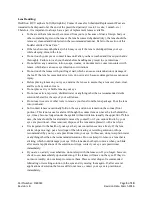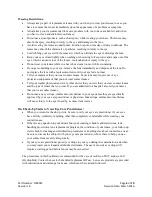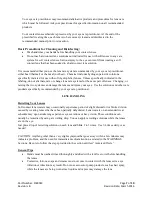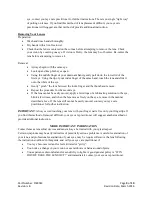
Part Number: PIB0013
Page
5
of
10
Revision: B
Revision Date: March 2016
Lens Handling:
Ocufilcon D UV asphere Soft (Hydrophilic) Contact Lenses for Scheduled Replacement Wear are
intended to be disposed of at the end of the prescribed period (1 week, 2 weeks, 1 month, etc.)
Therefore, it is important to always have a pair of replacement lenses available.
•
In the event that a lens must be removed from your eye because of dust, a foreign body or
other contaminant gets on the lens or the lens becomes dehydrated (dry), the lens should be
removed, cleaned and disinfected in the recommended manner. Refer to the section of this
booklet entitled “Lens Care.”
•
If the lens becomes dehydrated, which may occur if the lens is dislodged from your eye
while sleeping, discard the lens.
•
Do not touch your eyes or contact lenses until after you have washed and rinsed your hands
thoroughly. Failure to wash your hands before handling may result in eye infections.
•
Do not allow any cosmetics, lotion, soaps, creams, or deodorants to come into contact with
lenses, which also can cause eye infections or irritations.
•
Do not touch the lenses with your finger nail, which can cause contamination or damage of
the les. If the lens becomes nicked or torn, do not wear it, because damaged lenses can cause
injury.
•
Before placing lenses on your eyes, examine the lenses to assure they are moist, clean, clear,
and free of any nicks or tears.
•
Do not place a dry or brittle lens on your eye.
•
Do not use saliva, tap water, distilled water or anything other than a recommended sterile
solution labeled for the care of your soft lenses.
•
Do not use tweezers or other tools to remove your lens from the lens package. Pour the lens
into your hand.
•
Soft contact lenses occasionally fold on the eye and do not remain on the cornea (front
portion). This is not cause for alarm. Although the contact lens can never be lost behind the
eye, it may become lodged under the eyelids without irritation (usually the upper lid). IN this
case, the lens should be located and removed by yourself, or if you cannot find it, by your
eye care practitioner. Once removed, dispose of the lens and replaced it with a new lens.
•
It is important to the health of your eyes that your contact lenses move freely. If the lens
sticks (stops moving), put a few drops of the lubricating or rewetting solution or drops
recommended by your eye care practitioner into your eye. In this case, do not use plain water
or anything other than the recommended solutions. Do not attempt to remove a lens that is
sticking, which could damage your eye. If the lens does not begin to move when you blink
after several applications of the solutions or drops, contact your eye care practitioner
immediately.
•
If you are on a daily wear schedule, do not sleep with the lenses on. If you forget, however,
check to see, immediately upon awakening, if the lenses will move on the eyes. If they do
not move readily, do not attempt to remove them. Place several drops of recommended
lubricating or rewetting solution in the eyes and try moving them again. If, after several
applications of solution the lenses still do not move, contact your eye care practitioner
immediately.




























